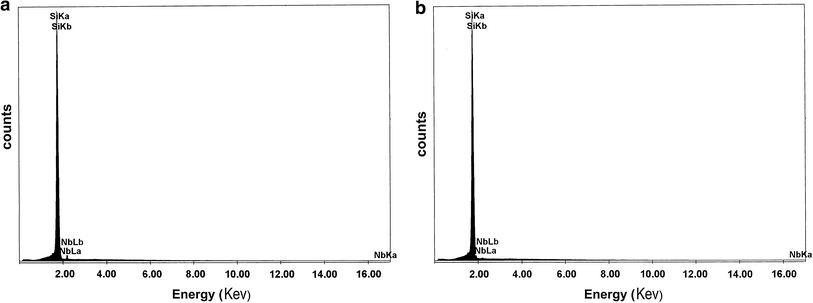
Published in Issue 2014-10-07
How to Cite
Abolhasani, J., Hassanzadeh, J., & Jalali, E. S. (2014). Ultrasensitive determination of lead and chromium contamination in well and dam water based on fluorescence quenching of CdS quantum dots. International Nano Letters, 4(4 (December 2014). https://doi.org/10.1007/s40089-014-0120-9
HTML views: 4
PDF views: 31
Abstract
Abstract We report lead (Pb 2+ ) and chromium (Cr 3+ ) determination in several water samples obtained from Nahand dam, Karkaj and Azarshahr well, tab and mineral waters to study their contamination in these systems. Determination method is based on the characteristic aggregation and fluorescence quenching of synthesized CdS quantum dots (QDs) at 555 nm by considered cations. Water-soluble and biocompatible CdS QDs modified with thioglycolic acid have been synthesized in one step and characterized by fluorescence and absorption spectroscopy. The fluorescence intensity of CdS QDs is linearly proportional to Pb 2+ and Cr 3+ concentration from 0.8 to 100 and 3 to 400 ng mL −1 with a detection limit of 0.3 and 1.2 ng mL −1 , respectively. Other potentially interfering ions such as iron, sodium, potassium, calcium, and magnesium ions did not affect the luminescence. The method showed lower detection blank and higher sensitivity.Keywords
- Lead,
- Chromium,
- Contamination,
- Fluorescence quenching,
- CdS quantum dots
References
- Landrigan and Todd (1994) Lead poisoning (pp. 153-159)
- Directive 2002/95/EC: Restriction of the use of certain hazardous substances in electrical and electronic equipment. European Parliament and Council (2003)
- Sadeghi and Mogaddam (2012) Preconcentration and speciation of trace amount of chromium in saline samples using temperature-controlled microextraction based on ionic liquid as extraction solvent and determination by electrothermal atomic absorption spectrometry (pp. 758-766) https://doi.org/10.1016/j.talanta.2012.07.018
- Sardans et al. (2010) Determination of As, Cd, Cu, Hg and Pb in biological samples by modern electrothermal atomic absorption spectrometry (pp. 97-112) https://doi.org/10.1016/j.sab.2009.11.009
- Orescanin et al. (2004) Determination of Cr(III) and Cr(VI) in industrial and environmental liquid samples by ED-XRF method (pp. 125-129) https://doi.org/10.1016/j.aca.2004.09.027
- Threeprom et al. (2005) Simultaneus determination of Cr(III)-EDTA and Cr(VI) by ion interaction chromatography using a C18 column (pp. 291-295) https://doi.org/10.1016/j.chroma.2004.09.053
- Dominguez and Arcos (2002) Simultaneus determination of chromium(VI) and chromium(III) at trace levels by adsorptive stripping voltammetry (pp. 241-252) https://doi.org/10.1016/S0003-2670(02)00757-2
- Li et al. (2009) Combining chemical reduction with an electrochemical technique for the simultaneous detection of Cr(VI), Pb(II) and Cd(II) (pp. 273-277) https://doi.org/10.1039/B804670K
- Yasri et al. (2011) Chronoamperometric determination of lead ions using PEDOT: PSS modified carbon electrodes (pp. 2528-2533) https://doi.org/10.1016/j.talanta.2011.08.013
- Milne et al. (2010) Determination of Mn, Fe Co, Ni, Cu, Zn, Cd and Pb in seawater using high resolution magnetic sector inductively coupled mass spectrometry (HR-ICP-MS) (pp. 200-207) https://doi.org/10.1016/j.aca.2010.03.027
- Beceiro-Gonzalez et al. (2009) Optimisation of a headspace-solid-phase micro-extraction method for simultaneous determination of organometallic compounds of mercury, lead and tin in water by gas chromatography–tandem mass spectrometry (pp. 5563-5569) https://doi.org/10.1016/j.chroma.2009.05.056
- Chai et al. (2010) Colorimetric detection of Pb2+ using glutathione functionalized gold nanoparticles (pp. 1466-1470) https://doi.org/10.1021/am100107k
- Hosseini and Belador (2009) Cr(III)/Cr(VI) speciation determination of chromium in water samples by luminescence quenching of quercetin (pp. 1062-1067) https://doi.org/10.1016/j.jhazmat.2008.10.084
- Kwon et al. (2005) A highly selective fluorescent chemosensor for Pb2+ (pp. 10107-10111) https://doi.org/10.1021/ja051075b
- Chen and Huang (2002) A highly selective fluoroscent chemosensor for lead ions (pp. 6246-6247) https://doi.org/10.1021/ja025710e
- Bozkurt et al. (2009) Fluorescence-based sensor for Pb(II) using tetra-(3-bromo-4-hydroxyphenyl) porphyrin in liquid and immobilized medium (pp. 880-883) https://doi.org/10.1016/j.saa.2008.12.012
- Michalet et al. (2005) Quantum dots for live cells, in vivo imaging, and diagnostics (pp. 538-544) https://doi.org/10.1126/science.1104274
- Alivisatos (2004) The use of nanocrystals in biological detection (pp. 47-52) https://doi.org/10.1038/nbt927
- Chen and Rosenzweig (2002) Luminescent CdS quantum dots as selective ion probes (pp. 5132-5138) https://doi.org/10.1021/ac0258251
- Xia and Zhu (2008) Use of surface-modified CdTe quantum dots as fluorescent probes in sensing mercury (II) (pp. 215-221)
- Cai et al. (2006) Preparation, characterisation and evaluation of water-soluble l-cysteine capped CdS nanoparticles as fluorescence probe for detection of Hg(II) in aqueous solution (pp. 234-239) https://doi.org/10.1016/j.aca.2005.11.061
- Li et al. (2008) A luminescent nanosensor for Hg(II) based on functionalised CdSe/ZnS quantum dots (pp. 119-123) https://doi.org/10.1007/s00604-007-0816-x
- Chen and Gao (2006) A novel fluorescent array for mercury (II) ion in aqueous solution with functionalized cadmium selenide nanoclusters (pp. 77-84) https://doi.org/10.1016/j.aca.2006.06.039
- Koneswaran and Narayanaswamy (2009) Mercaptoacetic acid capped CdS quantum dots as fluorescence single shot probe for mercury(II) (pp. 91-96) https://doi.org/10.1016/j.snb.2008.09.011
- Gattas-Asfura, KM., Leblanc, RM.: Peptide-coated CdS quantum dots for the optical detection of copper (II) and silver (I) Chem. Commun. 2684–2685 (2003)
- Fernandez-Arguelles et al. (2005) Surface-modified CdSe quantum dots for the sensitive and selective determination of Cu(II) in aqueous solutions by luminescent measurements (pp. 20-25) https://doi.org/10.1016/j.aca.2005.06.013
- Xie and Liang (2004) Luminescent CdSe- ZnS quantum dots as selective Cu2 + probe (pp. 2527-2530) https://doi.org/10.1016/j.saa.2003.12.039
- Zhang and Zhang (2008) l-Cysteine-coated CdSe/CdS core-shell quantum dots as selective fluorescence probe for copper(II) determination (pp. 142-147) https://doi.org/10.1016/j.microc.2008.01.008
- Koneswaran and Narayanaswamy (2009) L-Cysteine-capped ZnS quantum dots based fluorescence sensor for Cu2+ ion (pp. 104-109) https://doi.org/10.1016/j.snb.2008.09.028
- Chen and Zhu (2005) Functionalised cadmium sulfide quantum dots as fluorescence probe for silver ion determination (pp. 147-153) https://doi.org/10.1016/j.aca.2005.05.006
- Ali et al. (2007) Ultrasensitive Pb2+ detection by glutathione capped quantum dots (pp. 9452-9458) https://doi.org/10.1021/ac062068o
- Wu et al. (2008) A novel method for the determination of Pb2+ based on the quenching of the fluorescence of CdTe quantum dots (pp. 81-86) https://doi.org/10.1007/s00604-007-0801-4
- Cai et al. (2012) Ultrasensitive and rapid lead sensing in water based on environmental friendly and high luminescent L-glutathione-capped-ZnSe quantum dots (pp. 909-914) https://doi.org/10.1016/j.saa.2012.07.069
- Winter et al. (2005) Variation of cadmium sulfide nanoparticle size and photoluminescence intensity with altered aqueous synthesis conditions (pp. 147-157) https://doi.org/10.1016/j.colsurfa.2004.11.024
- Wang et al. (2011) Ultrasensitive cysteine sensing using citrate-capped CdS quantum dots (pp. 943-947) https://doi.org/10.1016/j.talanta.2010.10.047

 10.1007/s40089-014-0120-9
10.1007/s40089-014-0120-9











